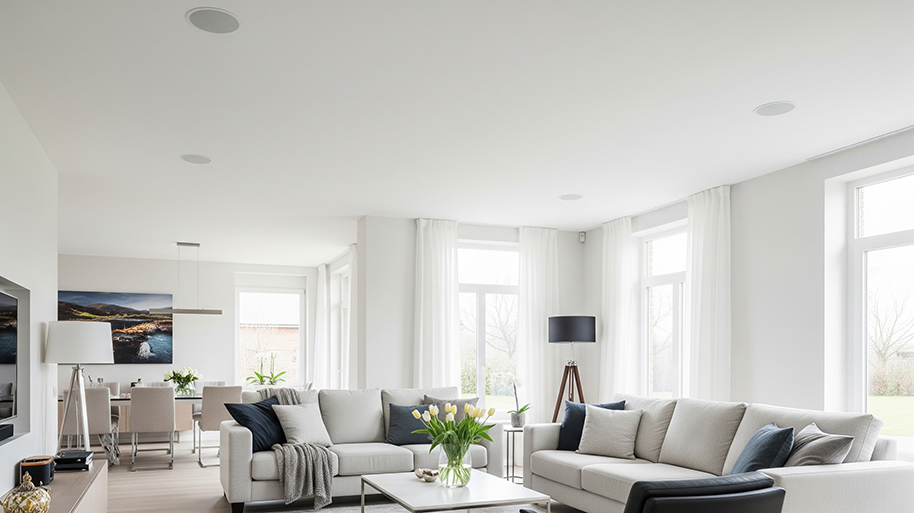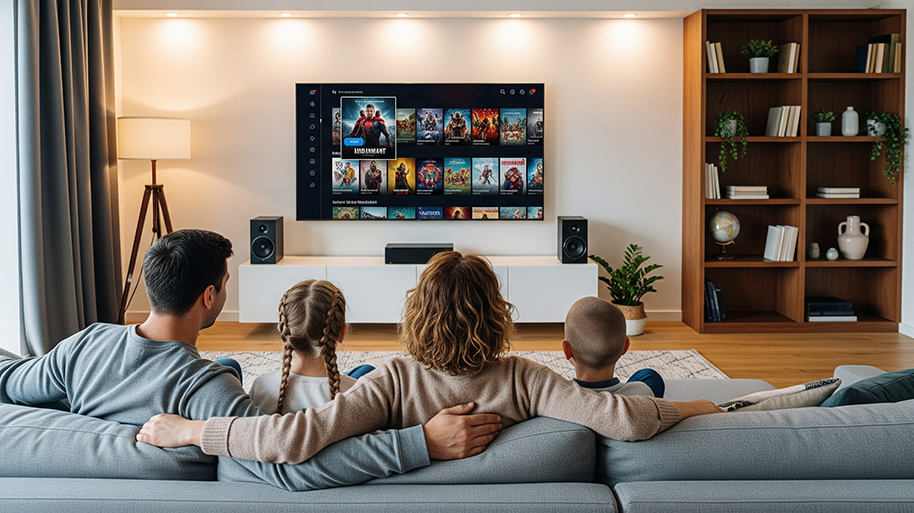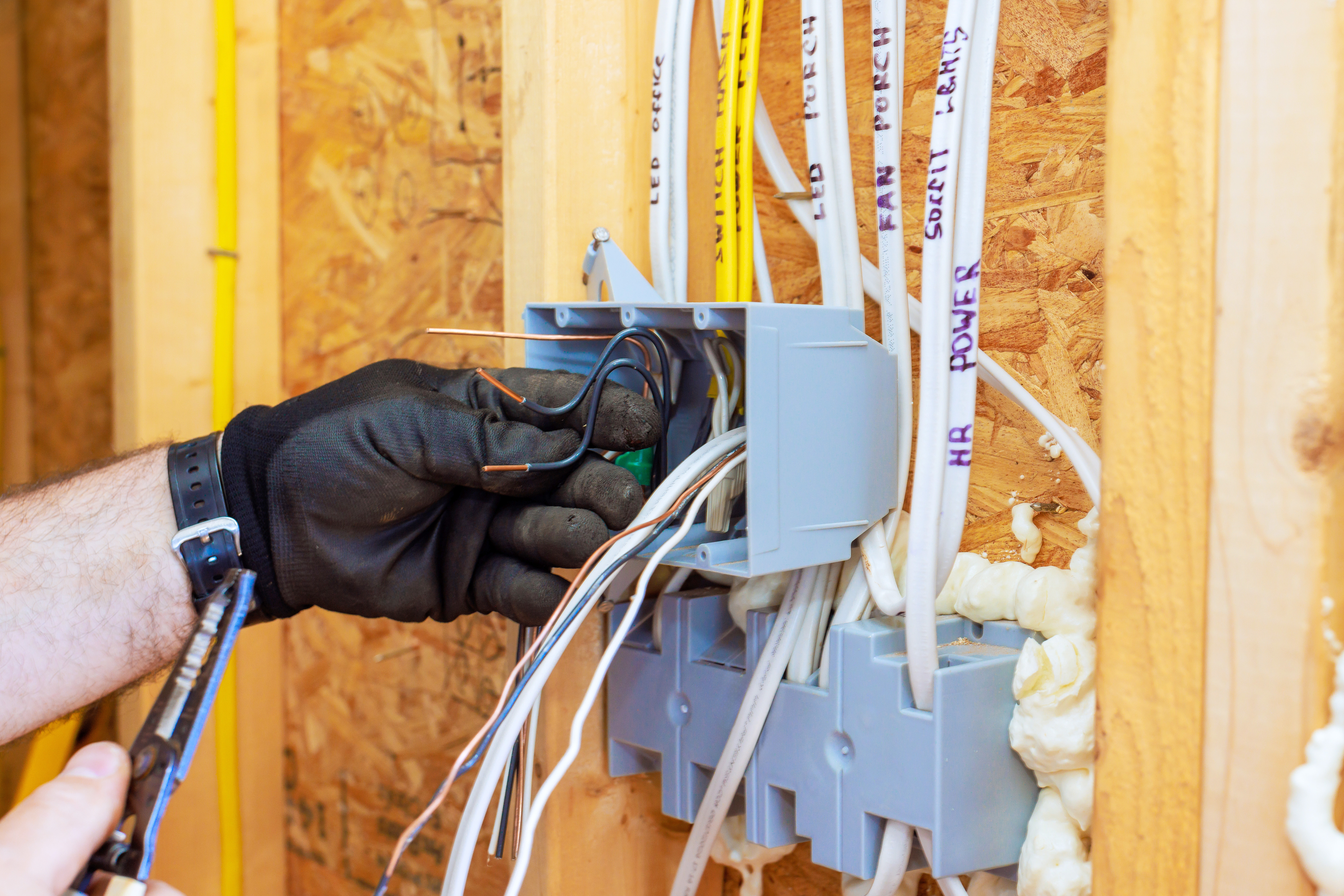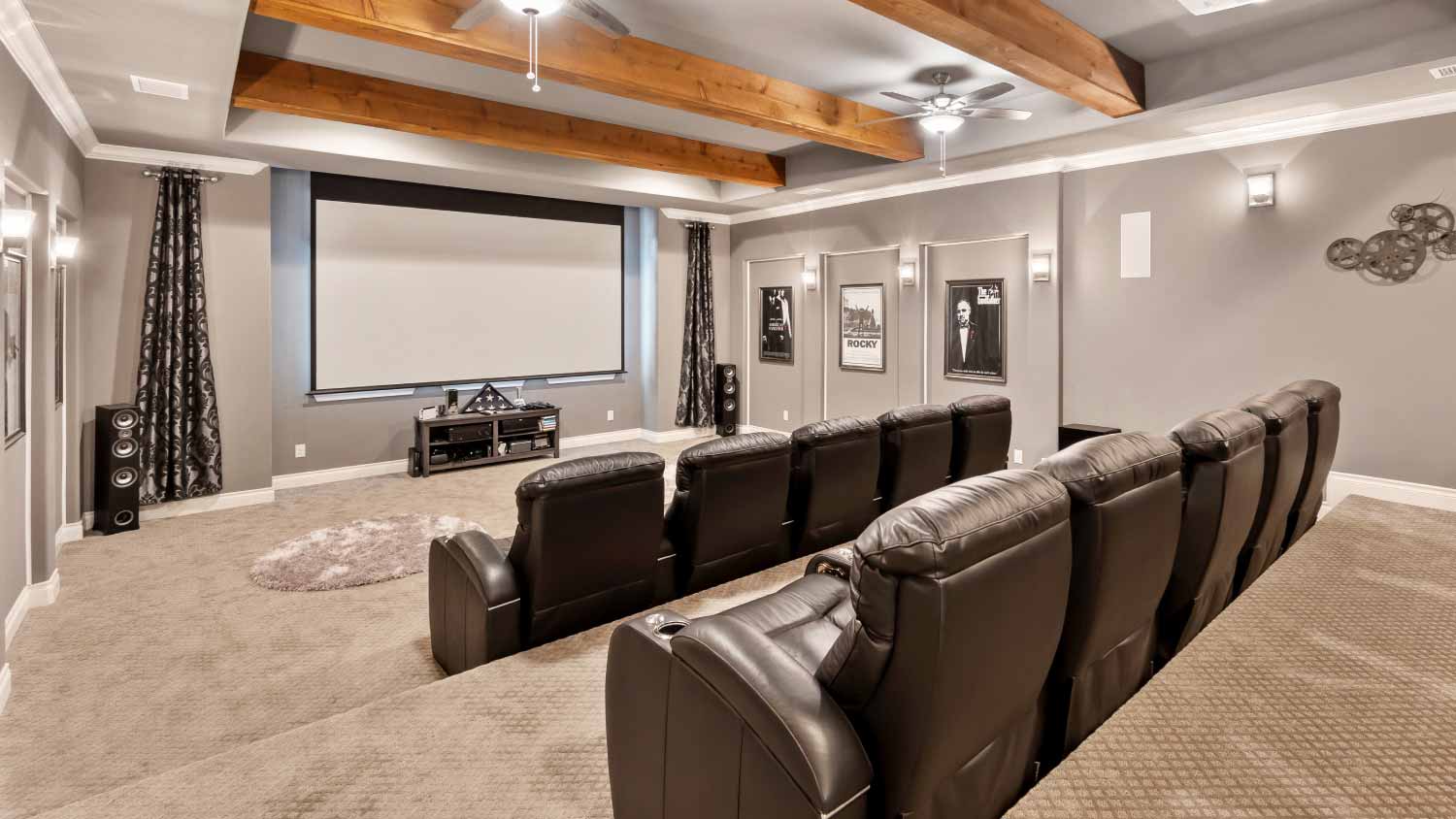
Whether you DIY or go with a pro will determine your ceiling speaker installation cost. Follow this guide to help you budget for your home audio project.
Home theater installation costs average $25,000, with homeowners spending $2,000 and $100,000. Your price depends on room size, equipment choices, and labor.


Home theater installation costs range from $100 to $250 per square foot, depending on room size, equipment quality, and custom features like soundproofing or automation.
Home theater installation transforms a room into a dedicated entertainment space with immersive audio and video.
A well-designed home theater can enhance your home’s value and create a high-end entertainment experience.
Professional installation ensures your system is safe, calibrated, and optimized for the best performance.
Consider add-on costs and plan for extras like wiring, permits, or post-project cleanup.
This article was created using automation technology and thoroughly fact-checked and edited by an Angi Editor in accordance with our AI policy.
Home theater installation cost averages $25,000, with an average range from $10,000 to $60,000. Basic setups cost as little as $2,000, but homeowners can pay up to $100,000 or more for high-end custom theaters. Most homeowners spend $100 to $250 per square foot, depending on room size, equipment, and features. Understanding these costs helps you budget for your ideal home theater.

The size of your home theater is one of the biggest factors in your total installation cost. Larger rooms require more equipment, materials, and labor, which increases the overall price. Home theater spaces range from a remodeled basement to a home addition for a dedicated theater room.
Converting an existing space is less expensive than building a new addition. However, the shape and ceiling height of the room can increase complexity and cost, especially if adjustments or soundproofing are needed.
| Room Size (Sq. Ft.) | Description | Cost Range |
|---|---|---|
| 100–200 | Small media room | $2,000–$5,000 |
| 200–400 | Medium-sized theater | $5,000–$20,000 |
| 400–800 | Large or dedicated theater | $15,000–$50,000 |
| 800+ | Luxury/custom home theater | $30,000–$100,000 |
The type of home theater installation you choose shapes your budget and the overall experience. Options range from basic setups in living rooms to fully custom, luxury theaters.
Pre-packaged systems are more affordable and easier to install, while custom installations offer more flexibility and high-end features. Each type comes with its own cost impact, including equipment, labor, and design.
| Home Theater Type | Description | Average Cost | Pros | Cons |
|---|---|---|---|---|
| Basic media room | TV, soundbar, basic seating | $2,000 | Quick, affordable, flexible | Limited immersion, fewer features |
| Dedicated theater room | Projector, surround sound, theater seats | $15,000 | Immersive, custom options | More expensive, needs more space |
| Luxury/custom theater | High-end AV, automation, custom design | $50,000+ | Premium experience, best features | High cost, longer installation |
Where you live affects home theater installation cost due to differences in labor rates, material availability, and local demand. Urban areas have higher costs because of increased wages and demand for specialized installers. In contrast, rural locations may offer lower prices but fewer options for experienced pros.
The area of your home chosen for the theater also impacts cost. Basements are popular for home theaters because they are naturally dark and quiet, but may require extra work for moisture control or egress. Living rooms, attics, and dedicated rooms each present unique challenges, such as accessibility, soundproofing needs, or structural modifications. These factors can increase labor costs and the need for additional materials.
Understanding what drives home theater installation cost helps you make informed decisions. Several core factors influence the final price.
Hiring a home theater system pro ranges from $50 to $150 per hour, depending on expertise and location. Some installers charge flat fees for standard setups, while custom jobs may include extra design or consultation fees. Labor costs cover wiring, TV mounting, system calibration, programming, and testing. Complex projects with hidden wiring or advanced controls increase the required hours and budget.
Home theater projects can involve multiple professionals, such as:
AV installers
Electricians
Carpenters
Designers
Permits are required for home theater installations that involve new electrical wiring, structural changes, or significant construction. Permit costs vary by location and project scope, ranging from $50 to $1,000. Inspections may be necessary for electrical or building code compliance, with additional fees for each inspection. Skipping permits can result in fines, failed inspections, or insurance issues, so it’s best to check local requirements before starting.
If you're aiming for a higher-end installation, consider the cost of these additional features:
Lighting: $150–$2,000
Furniture: $500–$20,000
Acoustic panels: $10–$100 per panel
Entertainment devices: $30–$500
Blackout curtains: $75–$400
Popcorn machine: $65–$600
Smart automation: $60–$4,500
Audio experiences are a major part of home theater experiences. Most home theater installations include surround sound systems, which average between $250 and $1,400 and include speakers, subwoofers, and other components. Expect upgrades to ceiling speakers or other high-end audio equipment to cost more.
Acoustic treatments and wall panels for better sound
Custom riser seating for stadium-style viewing
Built-in cabinetry and hidden wiring for a clean look
Soundproofing, blackout curtains, or dedicated HVAC systems
High-end projectors, large screens, and 4K or 8K video support
Beyond the basics, several other prep and cleanup elements affect your home theater installation cost. Site preparation, including demolition or structural modifications, add to project complexity and labor costs, as does the need to move heavy or bulky equipment. Additionally, keep professional design fees for layout, acoustics, or lighting plans in mind, and plan for post-constructural cleanup and debris removal. Being aware of these factors will help you plan for a complete and accurate budget.
Home theater installation cost goes beyond the initial setup. Plan for these ongoing or one-time expenses.
Extended warranties for equipment and installation can offer peace of mind. Manufacturer warranties cover defects for one to three years, while installer warranties may include labor and system support. Extended coverage adds to your cost, depending on the value and complexity of your system. Review what’s included to ensure you’re protected against major repairs or failures.
A home theater consumes more energy than a standard room, especially if you use large projectors, amplifiers, and multiple AV components. Expect to spend extra on electricity, depending on usage and equipment. Smart automation can help reduce energy waste by powering down devices when not in use.
Routine maintenance keeps your system performing at its best. This includes cleaning, calibration, and occasional software updates. Professional home theater repairs cost $40 to $800. Speakers and major components may last 10 years or more, but plan for periodic upgrades or replacements.
Sales tax applies to most home theater equipment and installation services. Rates vary by state and locality, so factor this into your budget. Large home improvements may also be subject to additional local or state taxes.
Upgrading your home with a theater may impact your homeowners insurance premium, especially if you add expensive AV equipment. Some policies require extra coverage for high-value electronics or custom installations. Consider the risks of damage or theft, and review your policy with your insurance provider before installation.
Some homeowners save on home theater installation costs by tackling the project themselves. DIY installation can reduce labor expenses, but it requires technical skill, time, and the right tools.
DIY costs include:
Equipment purchase
Wiring and cables
Mounting hardware and tools
Calibration devices
A DIY setup can cost less for equipment and materials, but you’ll invest significant time—20 to 60 hours or more for a high-quality result. Risks include improper wiring, equipment damage, safety hazards, and voided warranties. Professional installers deliver expert calibration and ensure your system is safe and optimized. Hiring a pro is best for complex or custom projects, where proper design and installation are essential for performance and safety.
Deciding whether to repair or replace home theater components depends on the issue, age of equipment, and overall system value. Simple repairs—such as fixing minor wiring problems, replacing a speaker, or changing a projector bulb—are cost-effective.
Replacement is recommended if your technology is outdated, equipment has major failures, or repairs cost more than 50% of the price of new components. Check warranty status and consider the age of your system. For instance, repairing a projector bulb may cost $100, while replacing the entire projector could cost $6,000. If your AV receiver fails after a decade of use, a new model may offer better performance and features for a similar investment.
A well-designed home theater can increase your property value and appeal to future buyers, especially in markets where entertainment spaces are in demand. ROI for home theater projects ranges from 50% to 80%, depending on quality, customization, and integration with the rest of the home.
Compared to other renovations like kitchens or bathrooms, home theaters offer unique appeal but may attract a more specific group of buyers. Benefits extend beyond financial value, adding enjoyment, convenience, and a luxury feel to your home. Factors that influence ROI include the quality of equipment, level of customization, and how well the theater integrates with your home’s design and local market trends.
Use these tips to streamline your home theater installation costs:
Talk to multiple installers: Get multiple quotes from qualified home theater installers for best pricing.
Stack services: Bundle installation with other home improvement projects for package deals.
Choose cost-effective upgrades: Choose budget-friendly equipment brands and limit custom features to essentials without sacrificing quality—add upgrades later if desired.
Schedule installation during slow seasons: Schedule installation during off-peak seasons for potential discounts.
Shop used: Look for used and refurbished equipment, and reuse existing wiring or components when possible.
Home is the most important place on earth, which is why Angi has helped more than 150 million homeowners transform their houses into homes they adore. To help homeowners with their next project, Angi provides readers with the most accurate cost data and upholds strict editorial standards. We extensively research project costs to develop the pricing data you see, so you can make the best decisions for you and your home. We rely on reputable sources, including the U.S. Bureau of Labor Statistics, academic journals, market studies, and interviews with industry experts—all to ensure our prices reflect real-world projects.
Want to help us improve our cost data? Send us a recent project quote to [email protected]. Quotes and personal information will not be shared publicly.
From average costs to expert advice, get all the answers you need to get your job done.

Whether you DIY or go with a pro will determine your ceiling speaker installation cost. Follow this guide to help you budget for your home audio project.

Find out what impacts TV repair cost. Learn average prices, key cost factors, and how to save when repairing your TV.

Discover the average surround sound installation cost, key price factors, and tips to save. Get expert insights to plan your home audio project.

Discover the average cost of home theater wiring, including labor, materials, and key factors that impact your total price. Learn how to budget and save on your project.

For a clean and safe installation, hire someone to mount the TV on the wall. Know how to prepare and what questions to ask before you call a pro for help.

Discover the average home theater repair cost, key price factors, and tips to save. Get transparent estimates and plan your repair with confidence.